New
Click-to-Instagram Direct Ads

If you are reading this, you must have already heard a thing or two about WhatsApp marketing. It's when businesses use WhatsApp to reach out to customers. Think of it as extending your casual, quick chats with friends to customer interactions. It's direct, personal, and lets you connect in real time.
WhatsApp marketing is catching on because it taps into how we already like to communicate.
You’re scrolling through WhatsApp, checking messages from friends, and then there’s a message from your favorite store. But it’s not spammy or too salesy. Instead, it feels like they know you. Maybe it’s a heads-up about a new product, a special offer, or a helpful tip related to something you bought recently. It’s personal, direct, and doesn’t feel like an ad. That’s WhatsApp marketing.
Businesses use it to send updates and create a kind of two-way street. You can ask questions and get quick replies, which all happens in this space that feels more private and secure. Plus, with features like broadcast, businesses can share their news without making it feel like a broadcast message. And then there are the chatbots for when human agents can’t be on the other end 24/7, ensuring you’re always there for your customers.
It’s about being where your customers are in a way that’s convenient and friendly for them. WhatsApp offers a refreshing change in a world where everyone’s tired of emails getting buried in their inbox. It’s quick, on your phone, and opens up a whole new way to engage with the people interested in what you offer.
So, you know how everyone’s inbox is a black hole for marketing emails? That’s why brands turn to WhatsApp to chat directly with their customers. It's like getting a VIP pass to your customer's attention, bypassing the crowded email party.
Let's get into the nitty-gritty. You might think, "WhatsApp costs more than e-mail because I'm paying per message, right?" But here's the twist: it's not just about how much you pay to send those messages; it’s about what you're getting back. Picture this: you've got a bunch of abandoned carts (we've all been there), and you're trying to win those customers back. If you shoot them a message on WhatsApp, you’re way more likely to get them to finish their purchase than if you sent an email. We’re talking a difference like getting 26-33% of those folks back with WhatsApp, compared to maybe 7-11% with email. When you do the math, including how much each of those sales is worth, WhatsApp starts looking like the better deal, doesn't it?
Now, why does WhatsApp work so well? It's simple. People read their WhatsApp messages. Imagine getting a message that feels like it’s just for you, with the option to chat back and forth or add something to your cart right from the app. It feels personal, immediate, and less like you’re being marketed to. Plus, WhatsApp doesn’t have to fight spam filters or get lost in a promotions tab. It's right there, mixed in with messages from friends and family.
You need a thorough understanding of your audience to get the most out of WhatsApp marketing. This involves more than just knowing their age or location—it's about knowing what they need, prefer, and expect from your brand. You can craft messages that resonate with them by analyzing their behavior and preferences, ensuring your communications are always relevant and welcomed.
Every message you send should offer something valuable to your recipient. This could range from informative content and exclusive offers to updates that align with their interests. The goal is to ensure that opening your message feels worthwhile, enhancing their perception of your brand.
Personalization is key to making your audience feel recognized and valued. Utilize your data—like previous purchases or interactions—to tailor your messages. This approach shows your commitment to meeting their needs and preferences, promoting a stronger connection between your brand and customers.
Visuals are powerful tools for capturing attention and conveying your message. Incorporating relevant images, videos, and GIFs can bring that edge to your messages, making them more engaging and memorable. Opt for content that complements your text and enhances the overall message you want to convey.
Effective marketing requires continuous adjustment and optimization. Keep a close eye on how your WhatsApp campaigns perform, identifying which strategies engage your audience most effectively. Regular analysis allows you to refine your approach, ensuring your marketing efforts remain effective and your messages continue to engage your audience.
Everyone is talking about how WhatsApp marketing can do this and that, but what makes it better than any other marketing platform? Check out these standout benefits that make WhatsApp a powerful tool in your marketing arsenal:
Using WhatsApp to send out broadcasts about new products, special sales, or any significant news is an efficient way to reach a broad audience instantly. Tailoring these broadcasts to highlight the most relevant information ensures your message is seen and acted upon. You can create multiple broadcast lists, which can be organized and labeled as your choice.
These ads bring audiences from Facebook and Instagram to a WhatsApp chat, seamlessly transitioning the customer from interest to engagement. They're especially effective for capturing potential customers' phone numbers and initiating a conversation.
Key benefits of running CTWA ads -
1- Get Qualified Leads without the hassle of Lead Generation Forms
2 - Track the Buyer's Journey
3 - Build Deeper Relationships with Potential Customers
4 - Reach Users Where They Are Most Active
5 - Measure Results beyond Conversations
6 - Lower Cost per Acquisition
7 - Provide Superior Customer Service
.webp)
Retargeting campaigns on WhatsApp can remind users of items they viewed but didn’t purchase or offer them personalized recommendations based on their browsing history. This strategy keeps your brand at the forefront of potential buyers' minds and encourages them to purchase.
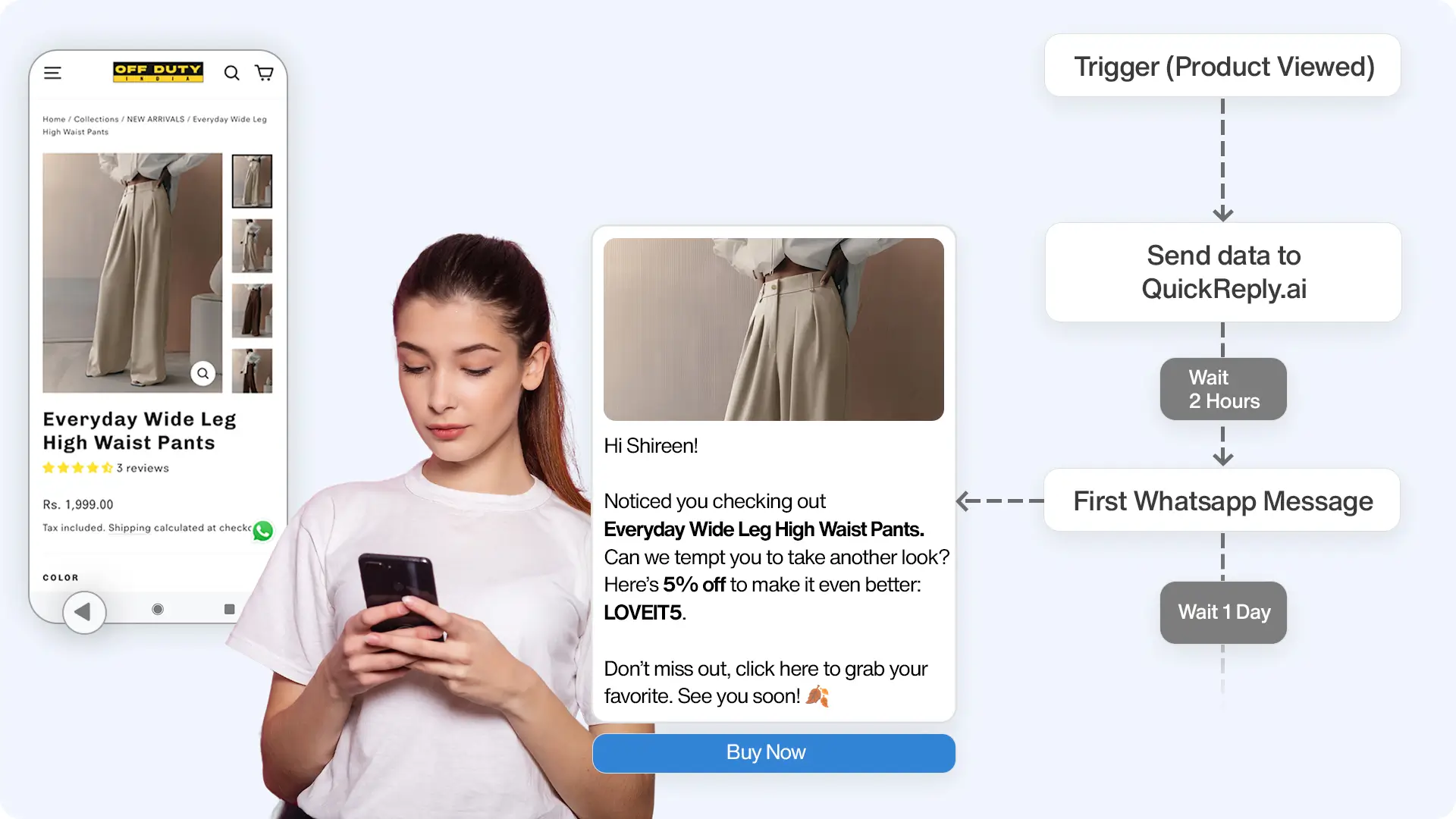
Deploying chatbots for WhatsApp enables your business to respond immediately to customer inquiries at any time, enhancing the customer experience. These bots can handle various queries, providing information and engagement even when live agents are unavailable.
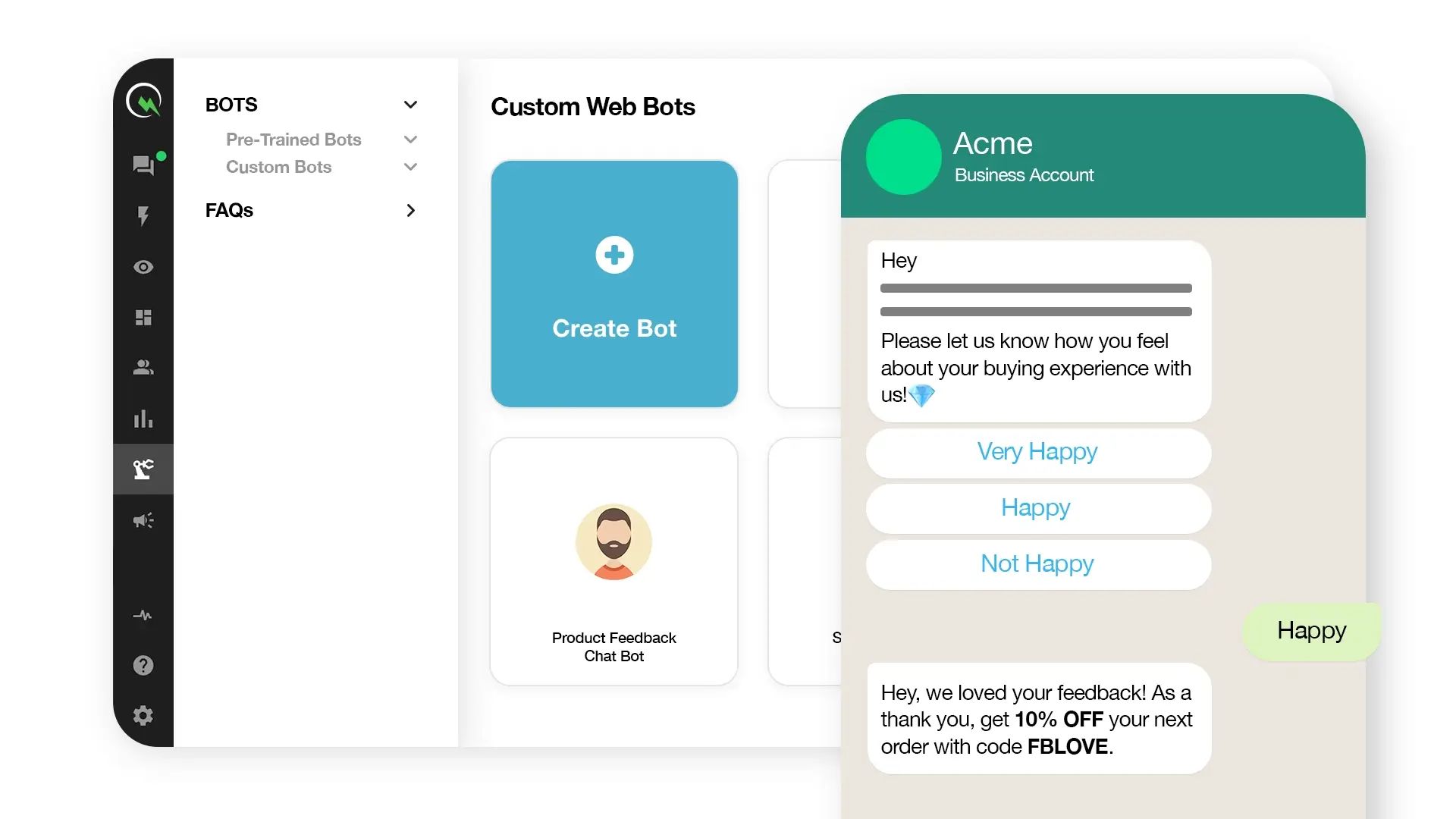
Incorporating a WhatsApp chat button or widget on your website offers a straightforward communication channel for visitors. This feature encourages direct engagement, making it easier for customers to reach out with questions or for support, thereby potentially increasing conversion rates.
Using quick reply and CTA buttons in your WhatsApp messages simplifies customer interaction, making it more likely they'll engage. This approach streamlines conversations and guides users toward the desired action, such as purchasing or learning more about a product.
Tailored messaging campaigns that address abandoned carts can significantly increase recovery rates. By initiating a conversation with a gentle reminder, followed by a compelling offer, and concluding with a feedback request if the cart remains abandoned, you can engage customers at multiple points and encourage them to complete their purchase.
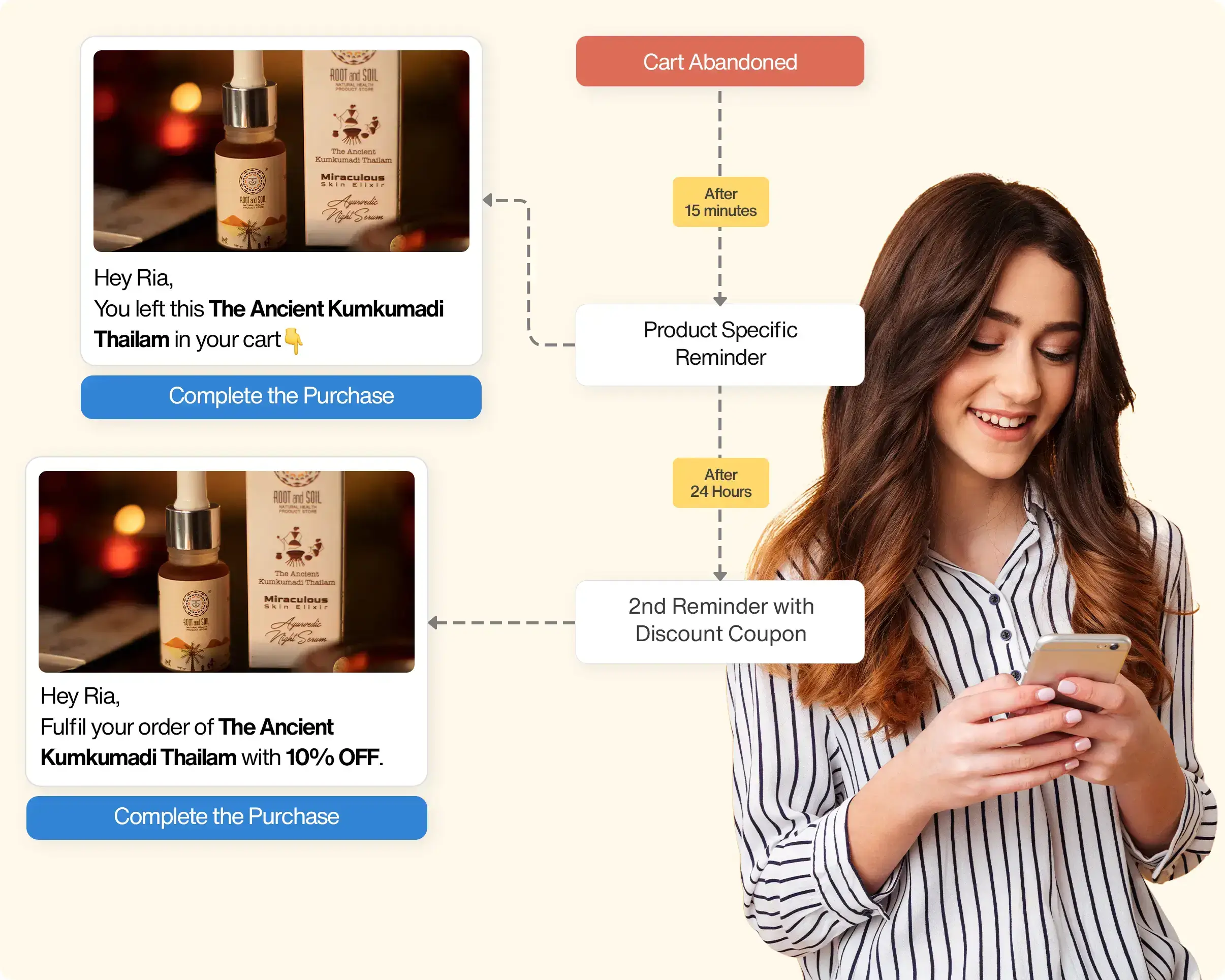
Automating personal reminders for birthdays, anniversaries, or other significant dates strengthens customer relationships. Offering special deals or messages on these occasions fosters a sense of personal care and loyalty.
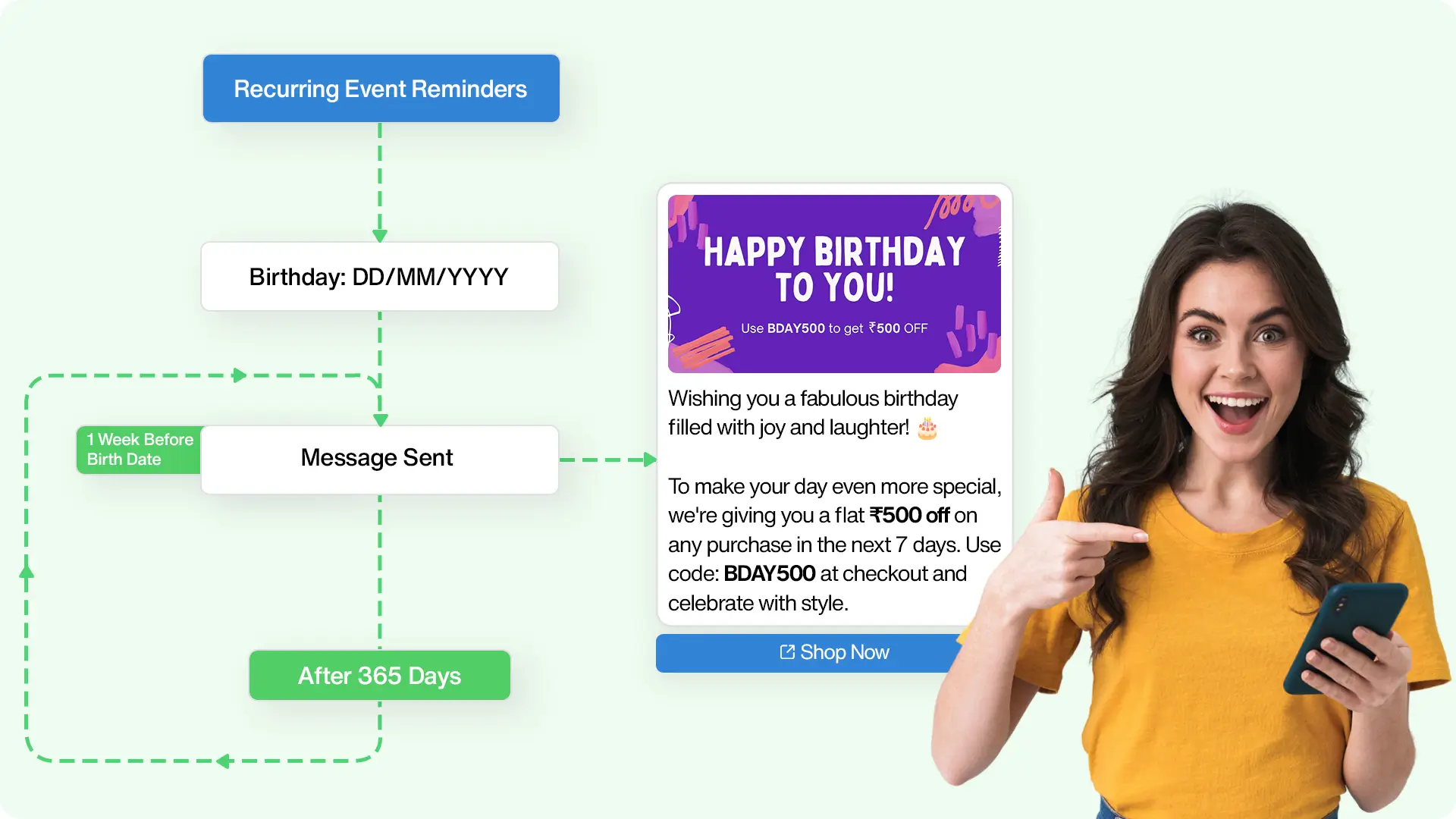
Reduce RTOs and NDR by nudging customers to convert COD orders to prepaid orders. Switching COD orders to prepaid isn't just about making things smoother for deliveries and cutting down on returns; it's also a smart way to save on costs. By sending out drip campaign reminders, you can incentivize customers to opt for prepaid methods by offering tangible benefits, such as discounts.
.webp)
Automated messages prompted by non-delivery reports (NDR) can help reduce return to origin (RTO) instances by asking customers to confirm their availability or update delivery details, improving overall delivery success rates.
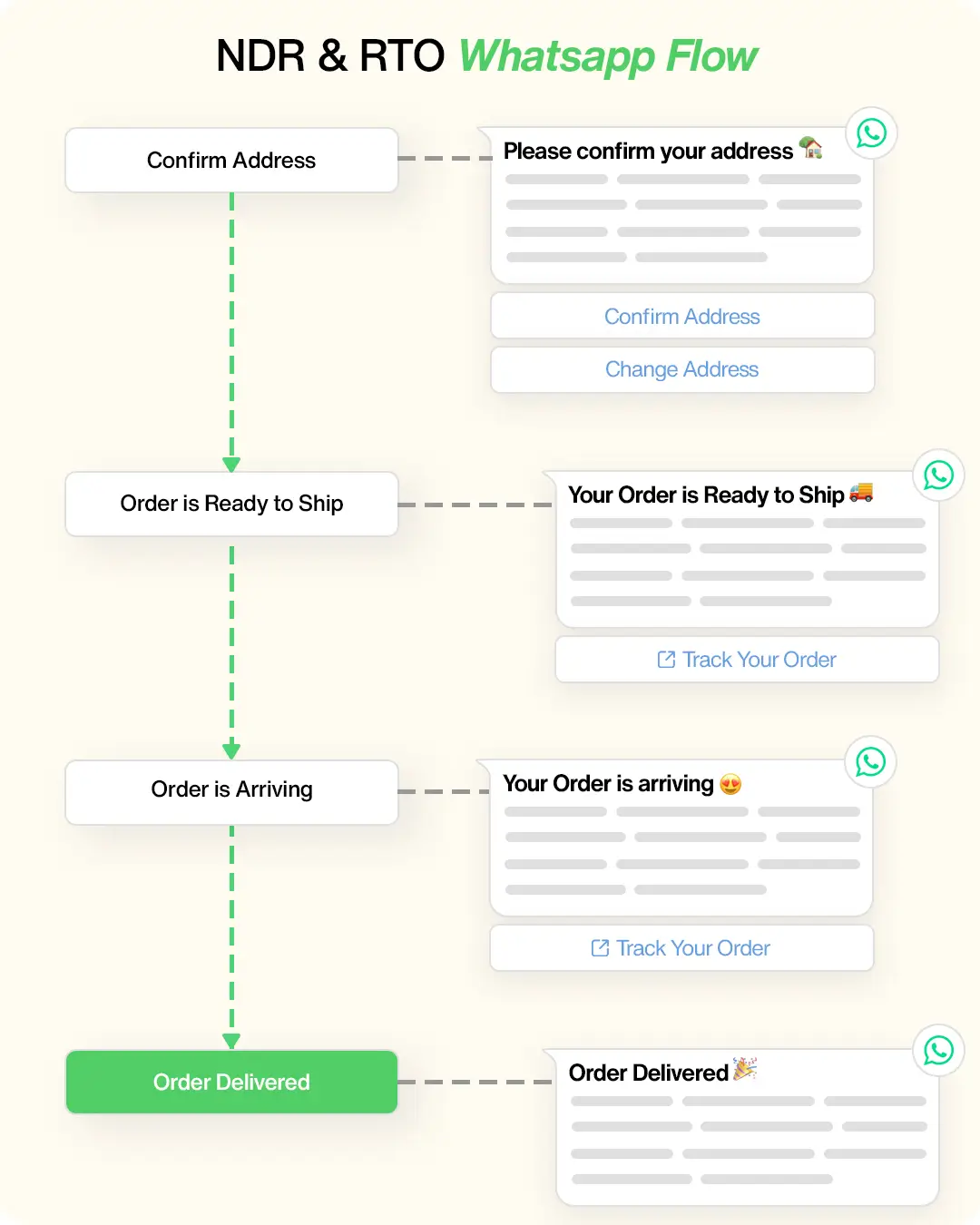
Running A/B tests on messaging strategies for cross-selling and up-selling through WhatsApp can identify the most effective tactics to drive repeat purchases, optimizing your marketing efforts.
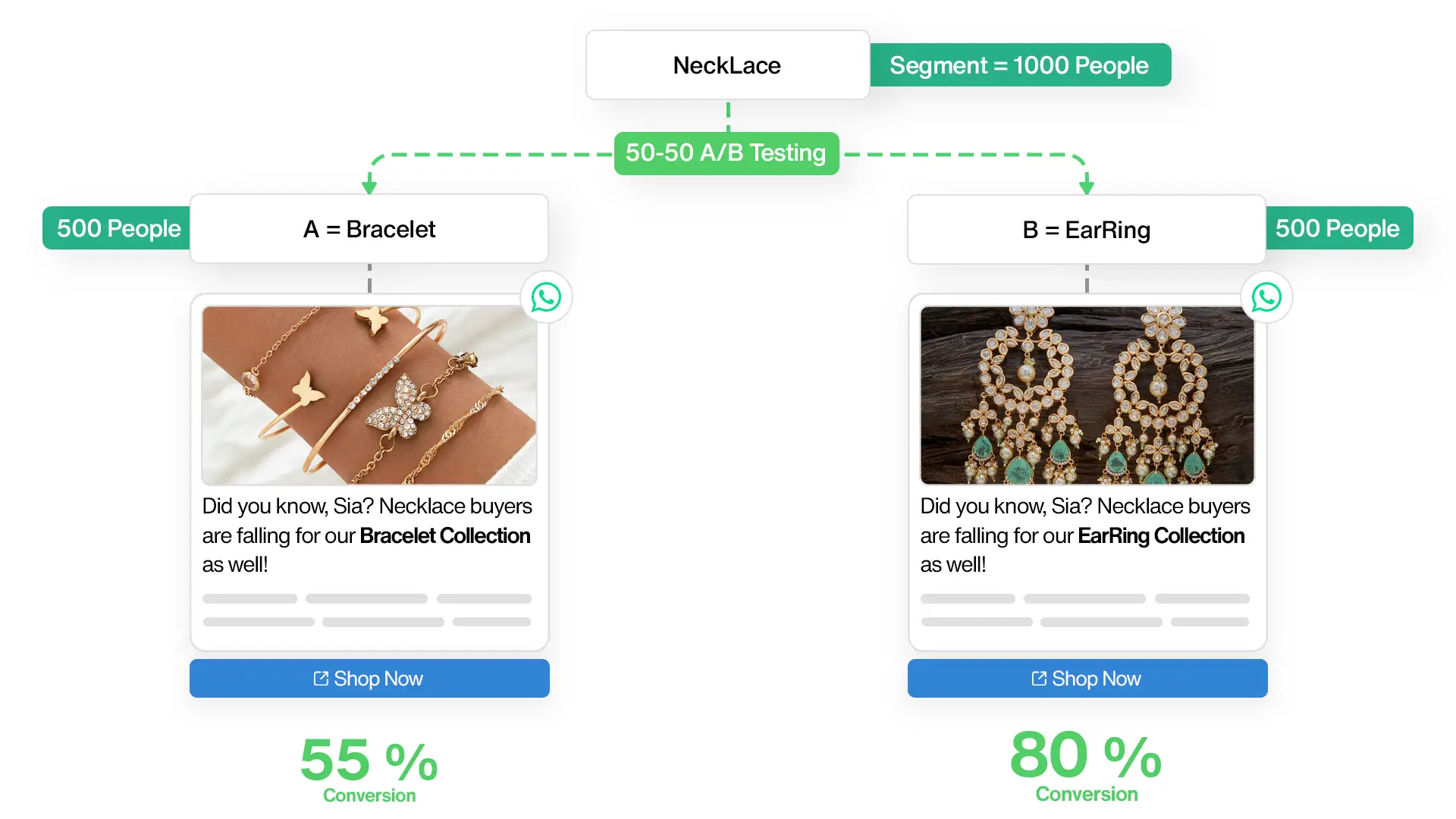
Sending automated messages that showcase items from the WhatsApp catalog can re-engage customers who have shown interest but have not made a purchase, encouraging them to revisit their decision.
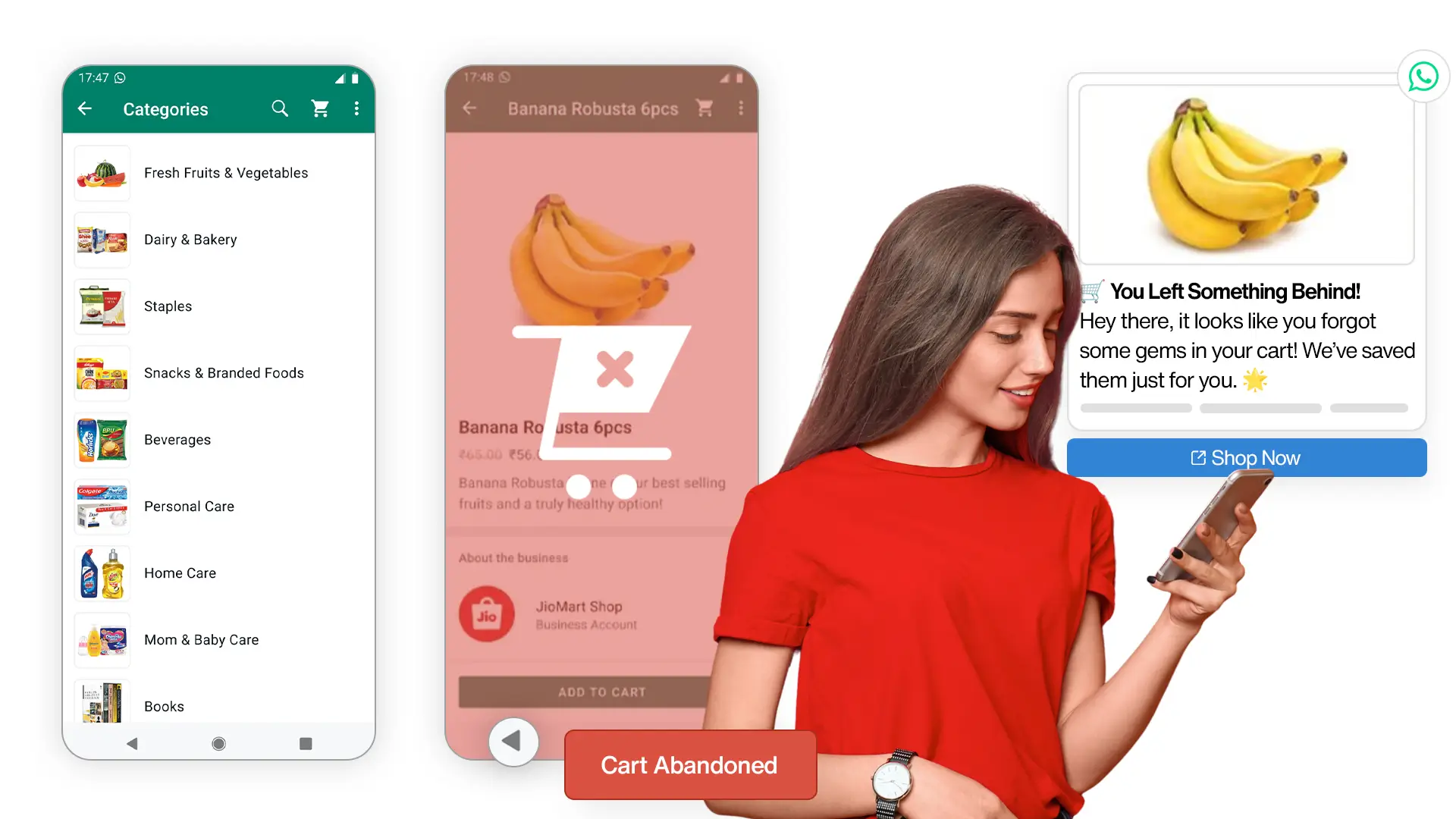
This feature targets visitors who have shown interest in products by viewing them but haven't taken action, using WhatsApp to send personalized offers and reminders, thus recovering potential lost sales.
Following up with users who disengage from conversations with your WhatsApp chatbot can recapture interest, offering personal assistance or addressing their last concerns, thus keeping potential leads warm.
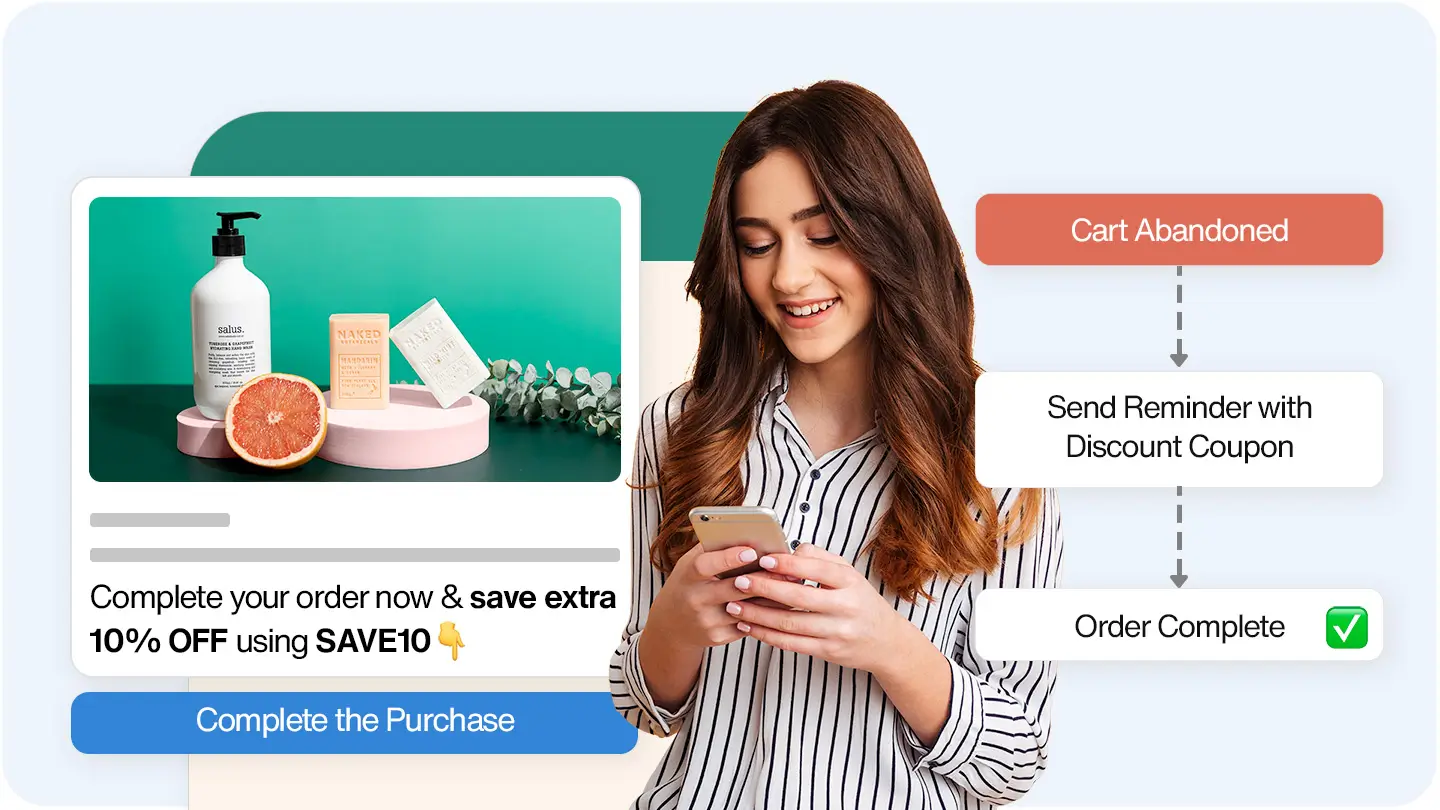
An automated sequence for new customers introduces them to your brand, highlights key products or services, and provides valuable content or offers. This series of messages can significantly enhance the customer experience and encourage loyalty and repeat business.
.webp)
Let’s peek at how some companies are nailing it with WhatsApp, turning messages into sales, and making customers feel like VIPs.
Thinking about giving your WhatsApp marketing a boost? QuickReply.ai is here to help with that. It's not just about sending a message when someone forgets to check out. We're talking about nifty features like noticing when someone's just browsing and not buying and giving you a way to remind them about what they were looking at.
And about geo-fencing—it's pretty cool because you can choose where your messages go. For example, if you want to avoid sending offers to certain places where you don't ship, you can do that. It makes things a lot more targeted and smart, right?
Plus, we've got this feature where you can send reminders based on the specific products people were interested in, not just a generic "hey, you forgot something" message. This makes the reminder feel more personal as if it's just for them.
So, if you're looking to make your WhatsApp chats a bit more clever and personal, QuickReply.ai has some tricks up its sleeve. Ready to see how it can change things for you? Let's get into it.
What's WhatsApp Marketing?
This is when businesses use WhatsApp to chat directly with customers. This includes sending offers, handling customer service, completing sales, and more through WhatsApp.
Is WhatsApp Marketing good for small businesses?
Absolutely! With its huge user base, WhatsApp is great for reaching out and connecting with customers. Small businesses can chat, make calls, and share media, helping to build stronger relationships with their audience.
Can I send offers to anyone on WhatsApp?
Nope, you've got to have permission. WhatsApp is strict about avoiding spam, so you can only message people who've given you consent. If you don't follow the rules, you might get banned.
How does the WhatsApp Business API fit into marketing?
The API lets you integrate WhatsApp messaging into your business systems. You can automate sending out information, handle customer questions, and even chat with many people at once.
Can I organize my WhatsApp contacts into groups?
WhatsApp doesn't sort your contacts for you, but you can manually organize them into lists based on what they buy or where they're from. This helps tailor your messages to fit different groups.
Is there a way to see how my WhatsApp campaigns are doing?
WhatsApp doesn't offer detailed analytics, but you can use tools or UTM codes in your links to gaug your campaigns' performance.
What costs are involved with WhatsApp marketing?
The basic WhatsApp Business app is free, but if you're using the API for a bigger business, you'll have costs based on the provider you choose, how many messages you're sending, and what extra features you want.
How can I get more engagement on WhatsApp?
Try sending photos and videos or using the quick reply feature to make chatting easier. Being prompt with customer support and sharing special deals or news can keep your audience interested. Plus, personalizing your chats can help.
Tool and strategies modern teams need to help their companies grow.
Leverage the untapped growth potential of WhatsApp marketing to acquire and retain customers.
Lorem ipsum dolor sit amet, consectetur adipiscing elit, sed do eiusmod tempor incididunt ut labore et dolore magna aliqua. Ut enim ad minim veniam, quis nostrud exercitation ullamco laboris nisi ut aliquip ex ea commodo consequat. Duis aute irure dolor in reprehenderit in voluptate velit esse cillum dolore eu fugiat nulla pariatur.
Block quote
Ordered list
Unordered list
Bold text
Emphasis
Superscript
Subscript